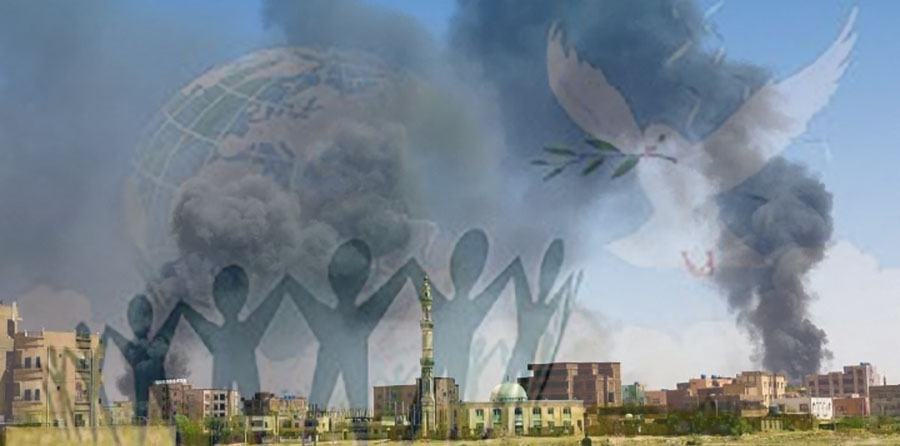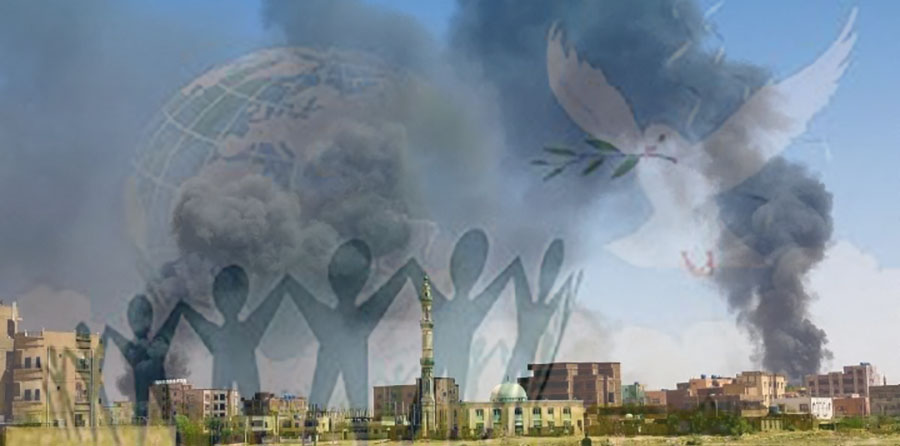
Concept of Peacebuilding
Fahil Jabbar Galabi
It can be said that the first features of the concept of peacebuilding are beginning to emerge with the 14 Wilson Principles, but this concept is beginning to evolve institutionally with the 1992 report of former United Nations Secretary-General Boutros-Ghali, incorporating four key terms that constitute an integrated cycle beginning with preventive diplomacy and continuing with peacemaking and peacekeeping to the peacebuilding phase.
The former Secretary-General of the United Nations (Boutros Boutros-Ghali) defined peacebuilding: what I mean by "post-conflict peacebuilding" is "end-of-conflict actions to promote peace and prevent the return of armed confrontation".
Norwegian sociologist John Kaltung defines peacebuilding as "the process of establishing self-supporting structures that eliminate the causes of war and offer alternatives to them in situations where wars may occur. Conflict resolution mechanisms should be integrated into the community structure and exist as a reservoir within the community system itself to rely on, just as a healthy body has the potential to generate its own antibodies, and does not need dedicated management such as medicine. "
Also, American writer John Paul Lederach defines peacebuilding as "A concept that incorporates the processes of local actions, which are all forces of society, individually and collectively and international institutions, non-international institutions and States aimed at revitalizing civil society, rebuilding infrastructure and restoring institutions shattered by war or civil strife of societies and such operations may seek to establish such institutions if they do not exist in such a way as to prevent the re-outbreak of war that would serve to strengthen the peacebuilding process ".
By analysing the definition of John Paul Lederach, we believe that he has identified the actions in the peacebuilding process, and that peacebuilding involves looking at the root causes of conflict by rebuilding the infrastructure as a whole and this is driving the end of conflict as a whole.
Thus, it is clear from the above definitions that peacebuilding is the participation of all segments of society and their various ethnic, religious, ethnic, national and intellectual affiliations in addressing the causes of conflict and achieving justice, and in conducting the humanitarian, reconstruction and economic construction of the State, which is essential after conflict has ended, at all levels from the top to the base of society.
Distinction between peacebuilding and its interrelated concepts
The concept of peacebuilding differs from a set of similar concepts, including:
1. Peacekeeping:
Peacekeeping is a term that is difficult to define precisely or is inclusive, preventive and comprehensive. It may be intended to facilitate the transition from conflict to peace, which is thus the midpoint between peace and war, and is defined as "The deployment of military and civilian personnel in the conflict zone with the consent of the parties to the conflict or national authorities, in order to cease or contain hostilities, supervise the implementation of the Peace Agreement, assist in humanitarian relief, as well as compliance with human rights and State-building" conflict ", a term that refers to all efforts undertaken during conflict to reduce or eliminate the manifestations of conflict and to stabilize conflict interactions with a degree of non-violence that can explore ways of managing and redressing conflict, and that peacekeeping is not intended to resolve conflict at its root but to reduce violence.
2. Making Peace:
There is no inclusive and comprehensive definition of the term peacemaking either, since each author addresses the concept according to the situation or the shape of the situation at all personal, national and international levels. There are many definitions that address this concept. There are those who know peacemaking as being "Activities aimed at concluding an agreement between hostile or belligerent parties through peaceful means, such as negotiation, mediation, arbitration, resort to regional agencies, conventions or other peaceful means." Peacemaking was also defined as "an approach to conflict resolution that relies heavily on meeting the needs of justice for society as a whole and not just the individual". Peacemaking refers to efforts and processes that involve any action aimed at pushing the warring parties to reach a peace agreement through peaceful means such as negotiation, dialogue between the parties and the use of diplomatic means to resolve the conflict, and it should be noted that peacemaking does not involve the use of military force against either party to end the conflict.
3. Peace Enforcement:.
This concept is intended to use armed force or threat to force the party concerned to comply with the decisions and sanctions imposed in order to maintain peace and order, and peace efforts may include non-military actions such as sanctions or military actions.
The above shows that the concept of peacebuilding is broader than other terms in that it is a broad process and encompasses many aspects of society. The transition from peacekeeping and peacemaking to peacebuilding was so fruitful that many thinkers worked to find a way to support peacekeeping and peacemaking operations and to try to find an alternative that would enable the conflicting parties to restore confidence and restore war-ravaged infrastructure for States as well as structural institutions. Peacebuilding was therefore linked to peacekeeping, as they represented some of the common principles and that was for the success of peace operations. Since 1980, peacekeeping forces, as well as a large number of civilian peacebuilding activists, have been deployed within States with the aim of maintaining order in them and helping to implement the conventions. There are processes that have brought together peacekeeping and peacebuilding.
Peacebuilding levels
Peacebuilding requires inviting all relevant political actors, organizations, activists and ethnic representatives from different groups within the State which encourages action to address challenges through the concept that change comes from the bottom of the Summit, Because from the top comes critical political decisions while detailed application is bottom-up. s role is great and comprehensive the easier it is to change and face challenges.
Peacebuilding involves examining the root causes of conflict by rebuilding the infrastructure as a whole, which is driving the end of the conflict as a whole. Laidrach outlined the time period for peacebuilding, which must be long-term. It also emphasizes that peacebuilding is primarily dependent on entering into relationships, with peacebuilding at several levels and working together: the grass-roots level represented by the people, the middle leadership level such as clergy, university professors, and the senior leadership level such as political leaders.
Peacebuilding addresses not only the remnants of war and conflict, but also the causes of conflict. and the peacebuilding study concludes that peacebuilding attempts involving the promotion and development of structural conditions, Attitudes and patterns of political behaviour that may allow for peaceful, stable and ultimately prosperous social and economic prosperity, It will be recalled that four main headings pertain to peacebuilding: Provide security, establish the social and economic foundations for long-term peace, establish the political framework for long-term peace, generate reconciliation that means healing from war wounds and justice.
The debate is whether the term "peacebuilding" refers to a direct end to violence or whether it addresses structural violence (Structural violence is one way of describing social arrangements that place individuals and populations according to certain arrangements or structures as integral to the political and economic organization of our social world, such as discrimination in education, employment, health care, globalization in economies, denial of rights and freedoms, apartheid.)
Structural violence refers to disabilities, disparities and even deaths resulting from discrimination of systems or institutions or policies that meet some peoples needs and rights at the expense of others of different ethnic, religious, caste or age. Many States are unable to provide an environment in which people can meet their basic needs, such as in societies that allow or encourage economic and social inequality, and that excludes some groups from participation in decision-making and public life, or direct harm to some people.
Other types of violence are direct violence, such as murder, beatings, torture, cultural violence, such as hatred, fear, mistrust, discrimination on the basis of sex, as well as intolerance. The task of post-conflict peacebuilding becomes very large, it is very difficult to assess, and the United Nations sometimes hesitates to use the term "peacebuilding" to refer to efforts to address structural violence.
Governments in post-conflict States are also concerned about "Mission transformation" or goal evolution, as in Iraq, as the US military has moved its stated mission several times the elimination of weapons of mass destruction by Saddam Hussein and the drafting of an Iraqi constitution democracy, elections and reconciliation of Iraqs ethnic groups and when the United Nations does not intervene or Governments do not have a concrete objective, Like a signed peace agreement, it becomes difficult to assess when they can leave context and transfer power appropriately to local leaders. Others insist that the term "peacebuilding" also include efforts to address the root causes of violent conflict.
The Institute of Multi-track Diplomacy refers to three broad types of peacebuilding:
a. " Political peacebuilding: agreement on legal issues, including formal negotiations, diplomacy, etc.
b. Structural peacebuilding: It relates to infrastructure and includes building economic, military, social and cultural aspects that support a culture of peace through activities such as voter awareness, the disarmament of belligerents and parties, police training, school building and good governance.
c. Social peacebuilding: it encompasses relationships and their interaction, such as feelings, attitudes, opinions, beliefs and values, through dialogue, community-building processes and activities, and training.
Similarly, Australian researcher Kevin Clement says that peacebuilding is the unmasking of the powerful, trying to create a parity in unequal relations. It places a focus on justice and equity rather than on maintaining harmony and the political system, and peacebuilding seeks to prevent, reduce and transform conflict and help people recover from violence in all its forms.
Peacebuilding requires a range of levels:
1. Advocacy for change: Its advocates and activists seek to garner support for change, which increases the Groups ability to address issues, and the necessary conditions mature.
2. Reducing direct violence: Actors seek to reduce direct violence by restricting perpetrators of violence and alleviating the direct suffering of victims of violence, thus creating a safe space for peacebuilding activities in other groups they address.
3. Transforming relationships: The goal is to transform destructive relationships and deal with a set of processes that address trauma, transform conflict and restore a sense of justice. These processes give people opportunities to meet their needs and create long-term and sustainable solutions.
4. Capacity-building: Longer-term peacebuilding efforts strengthen existing capacities and address needs, rights and violence prevention. These activities are aimed at building equitable structures that support a culture of sustainable peace.


